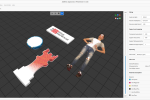Following the breakout success of Metaphor Refantazio, Atlus’ only action-RPG gets a second lease of life on Switch 2 (and it’s pretty good, too)
Soul Trader
Following the breakout success of Metaphor Refantazio, Atlus’ only action-RPG gets a second lease of life on Switch 2Nearly 20 years later, Devil Summoner: Raidou Kuzunoha vs. the Soulless Army proves that there’s a bit of life left in the peculiar spin-off series yet.
Image credit: Atlus
Article
by Dom Peppiatt
Editor-in-chief
Published on May 21, 2025
By now, you should know what to expect from an Atlus game. Whether you’re wading into the Boschian fever dream of Metaphor Refantazio or winding your way down the seven circles of hell in Shin Megami Tensei, Atlus likes it dark. Dark and weird. Unconstrained by the trappings of normalcy. A bit edgy and a bit juvenile, but all provocative and goth.
Raidou Kuzonha vs. The Soulless Army is no exception. The curious PS2 gamecarries on Atlus’ fascination with the occult and the Satanic, but with one major variation from all the developer’s other titles: this one is an action-RPG.
To see this content please enable targeting cookies.
Now, you need to immediately get your brain away from the idea it’s a Soulslike, or anything similar. It’s more of a hack-and-slash, peppered with the need for strategic flourish. Unlike previous MegaTen games, your protagonist, Raidou Kuzunoha, can attack with either his close range sword or his long range gun. But this wouldn’t be a MegaTen game without demons, so of course Kuzunoha can also summon two demons at a time to help in battle.
At launch, this game was fine. I’m a MegaTen sicko, so of course I played this as soon as it hit the PAL market. It wasn’t anything to write home about, really, and the combat was grating more than it was inventive. But, oh my, how all that has changed now - nearly two decades later.
Coming to the Switch 2 at launch, Devil Summoner: Raidou Kuzunoha vs. the Soulless Army Remastered is a bit of a misnomer. What we’re getting here is more of an enhanced version, and one that actually feels like a natural and intentional growth of the original game. And do you know why that is? Because, somehow, many of the same developers that worked on Raidou and its sequel during the PS2 era are still at the studio.
This is Tsuchigumo, and I don't think he likes you very much. | Image credit: Atlus
Yeah, I know, right? What’s effectively happened here is that Atlus has been able to say to its staff: “hey, remember that game you very nearly got right at launch in 2006? Have another swing at it. Load it with all those cool combat ideas you wanted, improve the systems, take what we’ve learned in the last 19 years and go wild”. And the result is an enhanced piece of niche role-playing history that plays better than ever.
First up, Atlus has remade the game’s pre-rendered backgrounds into actual 3D. Everything looked fine before, but now there’s more interactivity, more impetus to get off the beaten path. Atlus has crammed more demons into the roster, too, meaning you’ve got more freedom in how you approach battles, as well as more options for summoning and fusing. Again, this feels like a direct reply to criticisms of the game’s small offering at launch in 2006. If you’re a MegaTen sicko, you’ll appreciate the additions of demons like Idun, Hayataro, and more from SMT:5.
The combat upgrades themselves - more status effects, a more streamlined menu, more movement for Raidou in battle, more control over your demons - all seem to have been retroactively added into the game from the second in the series. No complaints, here; Devil Summoner 2: Raidou Kuzunoha vs. King Abaddon improved upon the first game in nearly every way. It makes for a far better experience than the original game, and one that actually stands up pretty well in 2025. It’s not exactly going to blow newcomers away, but it’s novel - and a perfect ‘on the go’ kinda game to show off on the Switch 2’s fancy hardware.
I'll defeat you with the power of friendship and this gun I found. | Image credit: Atlus
Another small quality-of-life thing that’s worth mentioning is the encounter rate. It’s been fixed. No more random encounters. Instead, demons are visible on-screen and youget to choose when to engage. To make things even more engaging, we’ve got English voice acting, too… And you know what? It’s pretty good!
And that may be what makes this re-release so appealing to me, actually. The original Raidou games contain some of the most enjoyable, and memorable, narrative moments from any title Atlus has ever made. Yes, that includes Persona. There is a humour to these games that really works - and the interactions between Raidou himself and his familiar cat Gouto is a great example of good games writing: tutorializing whilst delivering story.
Your demons have all those powers outside battle. The weird, occult-leaning setting of 1920s Japan is fairly unique, and Atlus does well to dive into how curious it is, understanding that it’s a time of change, a time of anxiety, but also of excitement and growth. Having this coloured in with competent and fun voice-acting is something I didn’t know I needed.
Batles are a bit complicated, but once you nail the rhythm, they work well. | Image credit: Atlus
This is a far better product than I was expecting, honestly. The Shin Megami Tensei 3 remaster was fairly basic and barebones, but this… this is a shining example of how you can re-release a game some 19 years later and have it actually offer something new, and fix things that the original version lacked. After a brief preview, this has gone from ‘hm, that’s interesting’ to ‘oh, well I’m going to buy that, then.’ Your mileage may vary, of course, but I think this is a fascinating example of what Atlus can cook up with its legacy titles.
Now, where’s my Digital Devil Saga 1 + 2 HD Remaster, ey?
#following #breakout #success #metaphor #refantazioFollowing the breakout success of Metaphor Refantazio, Atlus’ only action-RPG gets a second lease of life on Switch 2 (and it’s pretty good, too)
Soul Trader
Following the breakout success of Metaphor Refantazio, Atlus’ only action-RPG gets a second lease of life on Switch 2Nearly 20 years later, Devil Summoner: Raidou Kuzunoha vs. the Soulless Army proves that there’s a bit of life left in the peculiar spin-off series yet.
Image credit: Atlus
Article
by Dom Peppiatt
Editor-in-chief
Published on May 21, 2025
By now, you should know what to expect from an Atlus game. Whether you’re wading into the Boschian fever dream of Metaphor Refantazio or winding your way down the seven circles of hell in Shin Megami Tensei, Atlus likes it dark. Dark and weird. Unconstrained by the trappings of normalcy. A bit edgy and a bit juvenile, but all provocative and goth.
Raidou Kuzonha vs. The Soulless Army is no exception. The curious PS2 gamecarries on Atlus’ fascination with the occult and the Satanic, but with one major variation from all the developer’s other titles: this one is an action-RPG.
To see this content please enable targeting cookies.
Now, you need to immediately get your brain away from the idea it’s a Soulslike, or anything similar. It’s more of a hack-and-slash, peppered with the need for strategic flourish. Unlike previous MegaTen games, your protagonist, Raidou Kuzunoha, can attack with either his close range sword or his long range gun. But this wouldn’t be a MegaTen game without demons, so of course Kuzunoha can also summon two demons at a time to help in battle.
At launch, this game was fine. I’m a MegaTen sicko, so of course I played this as soon as it hit the PAL market. It wasn’t anything to write home about, really, and the combat was grating more than it was inventive. But, oh my, how all that has changed now - nearly two decades later.
Coming to the Switch 2 at launch, Devil Summoner: Raidou Kuzunoha vs. the Soulless Army Remastered is a bit of a misnomer. What we’re getting here is more of an enhanced version, and one that actually feels like a natural and intentional growth of the original game. And do you know why that is? Because, somehow, many of the same developers that worked on Raidou and its sequel during the PS2 era are still at the studio.
This is Tsuchigumo, and I don't think he likes you very much. | Image credit: Atlus
Yeah, I know, right? What’s effectively happened here is that Atlus has been able to say to its staff: “hey, remember that game you very nearly got right at launch in 2006? Have another swing at it. Load it with all those cool combat ideas you wanted, improve the systems, take what we’ve learned in the last 19 years and go wild”. And the result is an enhanced piece of niche role-playing history that plays better than ever.
First up, Atlus has remade the game’s pre-rendered backgrounds into actual 3D. Everything looked fine before, but now there’s more interactivity, more impetus to get off the beaten path. Atlus has crammed more demons into the roster, too, meaning you’ve got more freedom in how you approach battles, as well as more options for summoning and fusing. Again, this feels like a direct reply to criticisms of the game’s small offering at launch in 2006. If you’re a MegaTen sicko, you’ll appreciate the additions of demons like Idun, Hayataro, and more from SMT:5.
The combat upgrades themselves - more status effects, a more streamlined menu, more movement for Raidou in battle, more control over your demons - all seem to have been retroactively added into the game from the second in the series. No complaints, here; Devil Summoner 2: Raidou Kuzunoha vs. King Abaddon improved upon the first game in nearly every way. It makes for a far better experience than the original game, and one that actually stands up pretty well in 2025. It’s not exactly going to blow newcomers away, but it’s novel - and a perfect ‘on the go’ kinda game to show off on the Switch 2’s fancy hardware.
I'll defeat you with the power of friendship and this gun I found. | Image credit: Atlus
Another small quality-of-life thing that’s worth mentioning is the encounter rate. It’s been fixed. No more random encounters. Instead, demons are visible on-screen and youget to choose when to engage. To make things even more engaging, we’ve got English voice acting, too… And you know what? It’s pretty good!
And that may be what makes this re-release so appealing to me, actually. The original Raidou games contain some of the most enjoyable, and memorable, narrative moments from any title Atlus has ever made. Yes, that includes Persona. There is a humour to these games that really works - and the interactions between Raidou himself and his familiar cat Gouto is a great example of good games writing: tutorializing whilst delivering story.
Your demons have all those powers outside battle. The weird, occult-leaning setting of 1920s Japan is fairly unique, and Atlus does well to dive into how curious it is, understanding that it’s a time of change, a time of anxiety, but also of excitement and growth. Having this coloured in with competent and fun voice-acting is something I didn’t know I needed.
Batles are a bit complicated, but once you nail the rhythm, they work well. | Image credit: Atlus
This is a far better product than I was expecting, honestly. The Shin Megami Tensei 3 remaster was fairly basic and barebones, but this… this is a shining example of how you can re-release a game some 19 years later and have it actually offer something new, and fix things that the original version lacked. After a brief preview, this has gone from ‘hm, that’s interesting’ to ‘oh, well I’m going to buy that, then.’ Your mileage may vary, of course, but I think this is a fascinating example of what Atlus can cook up with its legacy titles.
Now, where’s my Digital Devil Saga 1 + 2 HD Remaster, ey?
#following #breakout #success #metaphor #refantazio













